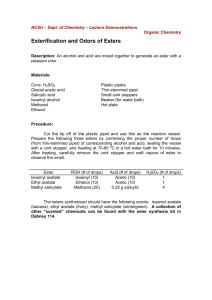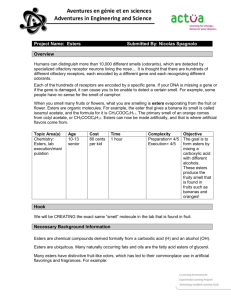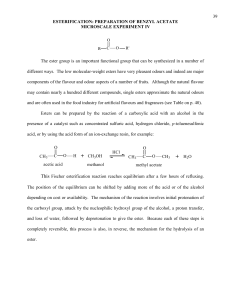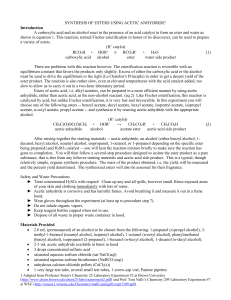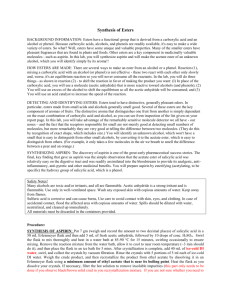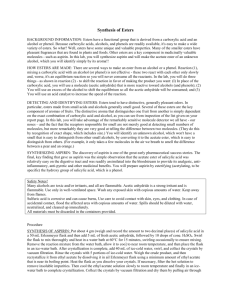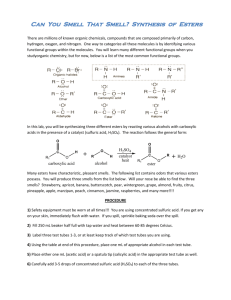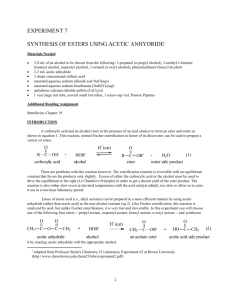making scents: synthesis of esters
advertisement
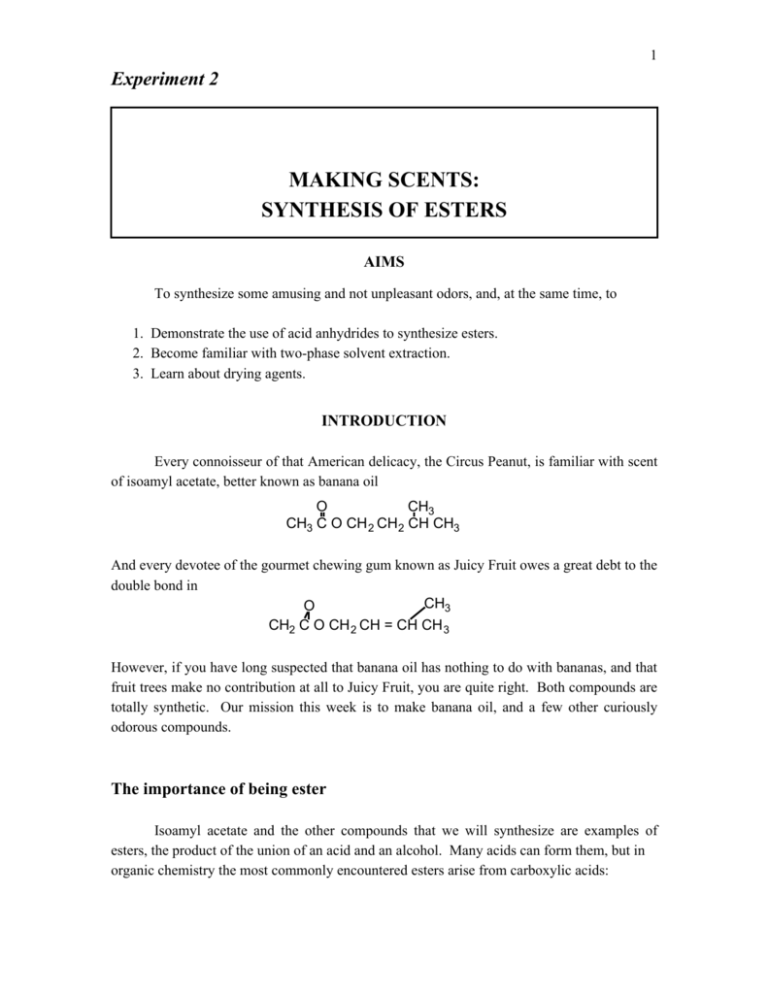
1 Experiment 2 MAKING SCENTS: SYNTHESIS OF ESTERS AIMS To synthesize some amusing and not unpleasant odors, and, at the same time, to 1. Demonstrate the use of acid anhydrides to synthesize esters. 2. Become familiar with two-phase solvent extraction. 3. Learn about drying agents. INTRODUCTION Every connoisseur of that American delicacy, the Circus Peanut, is familiar with scent of isoamyl acetate, better known as banana oil O CH3 CH3 C O CH 2 CH2 CH CH3 And every devotee of the gourmet chewing gum known as Juicy Fruit owes a great debt to the double bond in CH3 O CH2 C O CH 2 CH = CH CH 3 However, if you have long suspected that banana oil has nothing to do with bananas, and that fruit trees make no contribution at all to Juicy Fruit, you are quite right. Both compounds are totally synthetic. Our mission this week is to make banana oil, and a few other curiously odorous compounds. The importance of being ester Isoamyl acetate and the other compounds that we will synthesize are examples of esters, the product of the union of an acid and an alcohol. Many acids can form them, but in organic chemistry the most commonly encountered esters arise from carboxylic acids: 2 O O RCOH + R'OH RCOR' + H2O Our esters are odorous because they are small enough to be volatile, and that is why we are making them. However, besides being amusing, smelly esters are very important in the scheme of things for insects and plants that need pollination, or for humans whose lives depend upon plants. We are also dependent upon larger esters, which have no smell at all. ATP is a phosphate ester, as are most of the intermediates in carbohydrate metabolism. Cell membranes are constructed of phospholipids, which contain both phosphate and carboxylate ester groups. Energy is stored as glyceryl esters called fats. Coenzyme A, which is the key intermediate in energy metabolism, is an ester, but so are cholesterol esters, which are deposited in arteriosclerotic plaque. How to make ester Three methods are generally used to synthesize esters in the laboratory: 1. Reaction of a carboxylic acid with an alcohol in the presence of a catalyst (Fischer esterification). O RCOH + R'OH H+ O RCOR' + H2O (1) The usual catalysts are strong acids such as concentrated sulfuric acid, hydrogen chloride, or p-toluenesulfonic acid. Although widely used, Fischer esterification is an equilibrium reaction that usually must be refluxed for several hours. Furthermore, since the equilibrium does not lie far to the right, the yield is small unless excessive amounts of acid or alcohol are used. A case in point is the reaction of acetic acid with 1-propanol to give propyl acetate: O CH3 COH + CH3CH2CH 2OH H+ O CH3 COCH2CH2CH3 + H 2O (2) At equilibrium, the concentration of propyl acetate is given by [PrOAc] = k[PrOH] [HOAc] [H2O] ~ ~ 4 Thus, if equal quantities of acetic acid and 1-propanol are used, at equilibrium the theoretical yield of ester is only 67%. Tripling the amount of acetic acid or propanol increases the yield to 90%, and, to obtain a 95% yield, the amount of alcohol must be increased sixfold. 3 2. Reaction of an acid anhydride with an alcohol. O O O RCOCR + R'OH O (3) RCOR' + RCOH The reaction is irreversible and often rapid, and lies far to the right. Yields of nearly 100 percent can be obtained by using little or no excess acid anhydride. It is usually catalyzed by a strong acid such as concentrated sulfuric or perchloric. For instance, propyl acetate and acetic acid are formed by reacting acetic anhydride with 1-propanol: O O H+ CH3 C O C CH 3 + CH3CH 2CH2OH O O CH3 C O CH 2CH 2CH3 + CH3 COH (4) The reaction is in fact so rapid and exothermic that care must be taken to control it. 3. Reaction of an acid chloride with an alcohol. O O R C Cl + R'OH (5) RCOR' + HCl This is the reaction that you used to synthesize ethyl –3, 5 – dinitrobenzoate, the derivative for identifying your alcohol made by fermentation. Like acid anhydrides, acid chlorides frequently react quantitatively, and often rapidly. The synthesis of propyl acetate from acetyl chloride and propyl alcohol is O CH3 C Cl + CH2CH2OH O CH3 CO CH2CH2CH 3 + HCl (6) An organic base such as pyridine is usually added to neutralize the hydrogen chloride: = HCl N N H Cl- THE EXPERIMENT Although a natural odor often is caused by a blend of dozens of different compounds, some smells can be approximated by single esters. You will be asked to choose one of the four esters listed here, and to use acetic anhydride to synthesize it (equations 3 and 4). Their fragrances are said to suggest pears, bananas, peaches, and oranges, although when you smell them you might wonder whether the odor experts had dysfunctional noses. 4 You should save your new ester until next week, when we will measure its boiling point and examine its infrared spectrum. Ester Formula n-Propyl acetate bp(ºC) odor 102 pear 142 banana 206 peach 210 orange O O Isoamyl acetate O O Benzylacetate O O n-Octyl acetate O O PROCEDURE Wear gloves when using acetic anhydride. Gloves are not required after the product is washed twice. Read all of Technique 4, Extraction and Drying Agents, pages 724-749. The crude product will be extracted to remove sulfuric acid and unreacted acetic acid, and the purified product will be dried with anhydrous MgSO4. The same procedure is used for synthesizing all four esters. For each synthesis, the reaction and all subsequent extractions are carried out in a single test tube. The volumes of reagents required are: 5 n-Propyl acetate: 2.00 ml 1-propanol (n-propanol) 3.10 ml acetic anhydride Isoamyl acetate: 2.00 ml 3-methyl – 1- butanol (isoamyl alcohol) 2.20 ml acetic anhydride n-Octyl acetate: 2.00 ml 1-octanol (n-octanol) 1.50 ml acetic anhydride Benzyl acetate: 2.0 ml benzyl alcohol 2.30 ml acetic anhydride 1. Place the indicated volume of acetic anhydride in a large dry test tube, add 3 drops of concentrated sulfuric acid and mix thoroughly. Obtain 2.0 ml of one of the alcohols in a dry small test tube. 2. Hold the large test tube containing the anhydride in cold water (to cool the reaction), and add the alcohol to it in several increments; mix between additions. Without cooling, the strongly exothermic reaction could become too vigorous. Then place the tube in hot water at about 70º C for about 5 minutes to complete the reaction. 3. After 5 minutes, add eight drops of water (pasteur pipet). Mix briefly after each drop. The purpose is to hydrolyze excess acetic acid remaining after the esterification is complete. 4. Cool the reaction mixture, and add 6 ml of half-saturated sodium chloride solution (3 ml of saturated NaCl and 3 ml of distilled water) to the test tube. Mix thoroughly and vigorously, then set the tube aside until upper and lower phases form. The salt helps to break emulsions; if water alone were used, two phases would not separate easily. The upper phase is the ester, which is a volatile liquid. In the propyl acetate and isoamyl acetate syntheses, the phases separate cleanly within a minute or two. The octyl acetate and benzyl acetate produce turbid, milky emulsions which should be given five minutes to separate; for these two esters, both phases remain turbid even after separation. 5. The lower phase is a water solution of sulfuric and acetic acids, and should be removed and discarded. Use a pasteur pipet to remove it, but save it temporarily in another container before throwing it away. The last portion of the lower phase can be removed by placing the tip of the pasteur pipet (square end, not splintered) against the rounded bottom of the tube, and watching carefully as you slowly 6 withdraw the liquid. Do not be concerned if a few drops remain behind. Do not remove the upper phase (the ester) from the test tube. 6. Add 6.0 ml of saturated sodium bicarbonate to the upper phase in the test tube, mix vigorously, and allow up to 5 minutes for the phases to separate. The base neutralizes remaining acids, and helps to remove traces of acetic acid. Remove and discard the lower phase. Retain the upper phase. 7. Again wash the upper phase with 6.0 ml of half-saturated NaCl. Mix vigorously, and allow up to 5 minutes for the phases to separate. Remove and discard the lower phase, and retain the upper phase. 8. Wash the upper phase with 6.0 ml of saturated sodium chloride. Mix thoroughly, and allow the phases to separate. The upper phase (the ester) should not be turbid. Again remove and discard the lower phase, but this time try to remove every drop of it (without, of course, removing a significant amount of the ester). Because of its high osmotic pressure, the concentrated salt solution removes dissolved water from the upper phase (i.e. it dries the ester). 9. Transfer the upper phase (pasteur pipet) to a small test tube. Allow any water droplets to settle, and remove them with a pasteur pipet. Add about 1/3 volume of anhydrous magnesium sulfate (MgSO4) to the small test tube, and stir occasionally with a spatula for about 10 minutes. Allow the powder to settle. 10. Weigh a small vial and cap, and transfer the liquid (not the powder) to it with a pasteur pipet. To recover as much liquid as possible, place the (square, not broken) tip of the pipet against the bottom of the test tube. Almost no MgSO4 should be carried over to the vial. Cap the vial and weigh it. Add about 1/4 volume of MgSO4, cap it tightly, and store it in your locker. Check out the odor before storing the ester. Sniff gently; putting your nose nearly into the vial will overwhelm your ofactory machinery. Instead, place a drop or two on a piece of paper and gently waft the delightful fragrance in the direction of your nose. Try not to be too critical. When you smell propyl acetate, for instance, think pears. Pre-laboratory questions 1. Isoamyl acetate (banana oil, MW 130.2) is synthesized using 2.0 ml of 3 – methyl 1butanol (isoamyl alcohol, density 0.8092 g/ml, MW 88.2) and 2.20 ml of acetic anhydride (density 1.0820 g/ml, MW 102.1). The vial containing the purified ester weighs 6.9861 g, and empty the vial weighs 5.2800 g. 7 a) Determine the limiting reagent. Ans: isoamyl alcohol b) What percent excess acetic anhydride is present? Ans: 25 percent c) Calculate the theoretical yield. Ans: 2.39 g d) Calculate the percent yield. Ans: 71.3% 2. Give the chemical reasons for the following steps: a) Adding concentrated sulfuric acid. b) Immersing the test tube in cold water while adding the alcohol. c) Adding the alcohol in increments, and mixing after each addition. d) Heating the mixture after adding the alcohol. e) Extracting the reaction mixture. f) Extracting with half-saturated sodium chloride solution instead of water. g) Extracting with sodium bicarbonate. h) Extracting with saturated instead of half-saturated sodium chloride solution i) Adding anhydrous magnesium sulfate. ADDENDUM: MELTING POINTS Read Techniques 6.1, 6.2, and 6.3 on pages 765-776. There should be enough time this week to determine the melting point of your ethyl –3, 5 – dinitrobenzoate, which should be 93º C if the compound is pure. First, however, practice by determining the melting point of a known compound. 1. Measure the melting point of pure benzoic acid repeatedly until you obtain the correct value (122º C). Record the name of the apparatus, and the heating rate, heater setting, and observed melting points of consecutive runs (unless you do it correctly the first time). 2. Determine the melting point for your ethanol derivative. Again record the name of the apparatus, the heating rate, the heater setting, and the observed melting ranges of consecutive runs (if necessary)
